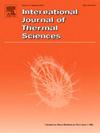Decoupling study on IGBT stress performance based on thermal-mechanical-electromagnetic multiphysics analysis
IF 4.9
2区 工程技术
Q1 ENGINEERING, MECHANICAL
International Journal of Thermal Sciences
Pub Date : 2025-02-20
DOI:10.1016/j.ijthermalsci.2025.109793
引用次数: 0
Abstract
The press-pack Insulated Gate Bipolar Transistor (IGBT) is a critical power device in high-power electronic equipment and widely employed in flexible direct current (DC) transmission systems. Electrothermal stress fatigue are the leading cause of IGBT failures in engineering applications. However, previous studies mainly focused on the stress analysis from individual mechanical field in IGBT, thus the coupling effects of thermal-mechanical-electromagnetic multiphysics fields on stress analysis are ignored, moreover, the thermal effect includes not only Joule heating but also electromagnetic losses, which lead to the interaction mechanisms on stress from various fields are currently unclear. In this paper, a novelty model of the IGBT considering mechanical field, thermal field, and electromagnetic field is proposed to comprehensively understand their inherent interaction mechanisms. Detailly, the paper explores the interaction mechanisms between fields by gradually coupling different fields. As a results, compared to the single mechanical field model, after thermal field is coupled into the mechanical field, the maximum stress steep rise to 26.2 MPa from 12.8 MPa. The electromagnetic field is further coupled into the mechanical-thermal fields, and the maximum temperature is increased by 6.2 %, which further leads to a 12.9 % increase in the maximum stress of mechanical field. The multiphysics coupling model has significantly narrowed the gap with the experimental results, the deviation in maximum stress has been reduced from 55.33 % in individual mechanical field to 2 % in Thermal-Mechanical-Electromagnetic multiphysics fields. The results indicate that the sequential coupling of thermal and electromagnetic fields significantly enhances the accuracy of stress analysis of IGBT.
求助全文
约1分钟内获得全文
求助全文
来源期刊

International Journal of Thermal Sciences
工程技术-工程:机械
CiteScore
8.10
自引率
11.10%
发文量
531
审稿时长
55 days
期刊介绍:
The International Journal of Thermal Sciences is a journal devoted to the publication of fundamental studies on the physics of transfer processes in general, with an emphasis on thermal aspects and also applied research on various processes, energy systems and the environment. Articles are published in English and French, and are subject to peer review.
The fundamental subjects considered within the scope of the journal are:
* Heat and relevant mass transfer at all scales (nano, micro and macro) and in all types of material (heterogeneous, composites, biological,...) and fluid flow
* Forced, natural or mixed convection in reactive or non-reactive media
* Single or multi–phase fluid flow with or without phase change
* Near–and far–field radiative heat transfer
* Combined modes of heat transfer in complex systems (for example, plasmas, biological, geological,...)
* Multiscale modelling
The applied research topics include:
* Heat exchangers, heat pipes, cooling processes
* Transport phenomena taking place in industrial processes (chemical, food and agricultural, metallurgical, space and aeronautical, automobile industries)
* Nano–and micro–technology for energy, space, biosystems and devices
* Heat transport analysis in advanced systems
* Impact of energy–related processes on environment, and emerging energy systems
The study of thermophysical properties of materials and fluids, thermal measurement techniques, inverse methods, and the developments of experimental methods are within the scope of the International Journal of Thermal Sciences which also covers the modelling, and numerical methods applied to thermal transfer.
 求助内容:
求助内容: 应助结果提醒方式:
应助结果提醒方式:


